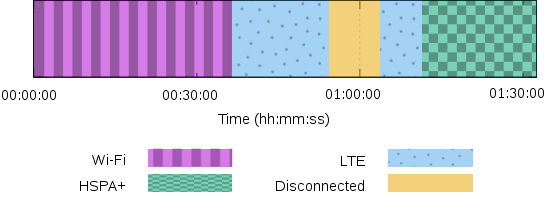Several field experiments have been conducted to evaluate the Sherpam system in real conditions. One of these experiments involved a volunteer carrying an ECG sensor (Zephyr belt), a GPS receiver (QStarz), and a smartphone configured with the Sherpam application. During this particular field test, which lasted 90 minutes, the volunteer moved in different settings, which allowed the Sherpam system to switch several times between wireless transmission technologies.
The figures below show the distribution of the time spent using each kind of transmission technology (a), and the timeline of wireless connections (b).
Figure 1: Distribution of the time spent using each kind of transmission technology (a) and timeline of wireless connections during an experiment using the Sherpam application for 90 minutes during which the user was wearing a Zephyrbelt and a QStarz GPS receiver.
During the first 30 minutes of the field test, the volunteer sat in his office. The Sherpam system therefore relied on the local corporate Wi-Fi network to upload data to Sherpam’s aggregation server. The volunteer then walked to the nearest bus station, where he took a bus to go home. During that period the Sherpam system first switched to an LTE network, failed to ensure connectivity for a while, restablished LTE connectivity, and eventually switched to HSPA+ connectivity instead.
This example confirms the resilience of the Sherpam system when connectivity conditions keep changing over time.
Figure 2 shows the evolution of the number of data bundles stored in the cache of the application. During this field test, a new data bundle was produced every 20 seconds, this bundle containing data acquired from the ECG sensor and GPS receiver. The application was configured to send all cached bundles to the remote server every minute, provided a wireless network was available to do so.
In the figure it can be observed that switching between transmission technologies did not disrupt the rythm of bundle transmissions. The Sherpam system however observed an episode when no wireless network was available. During that episode, data bundles were simply maintained in the local cache, and the got transmitted as soon as connectivity was re-established.



